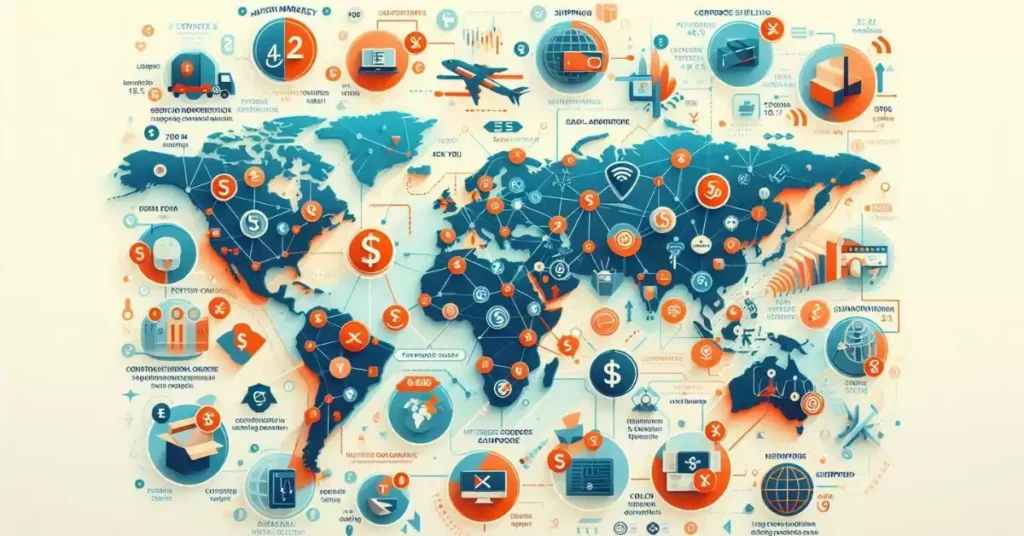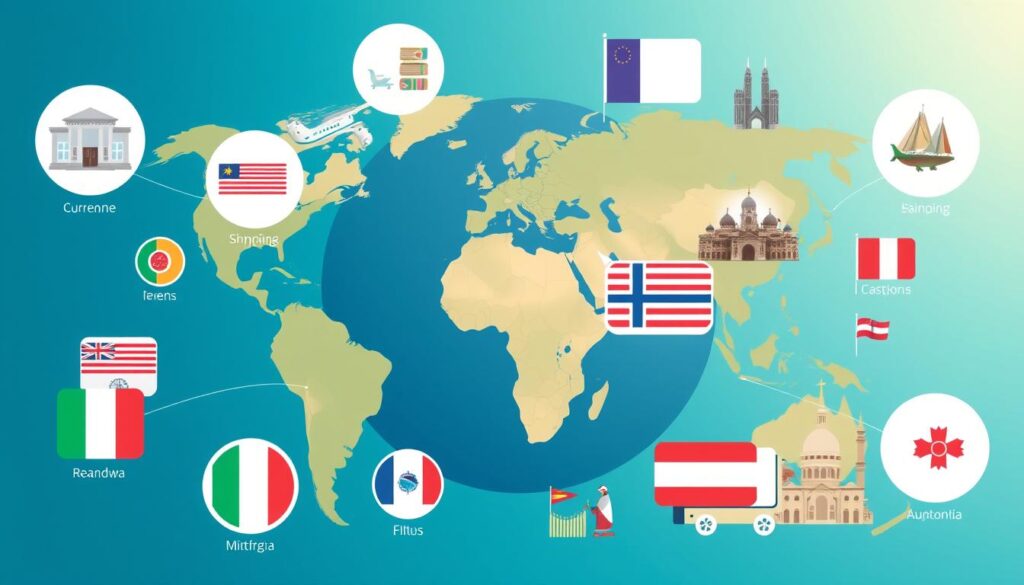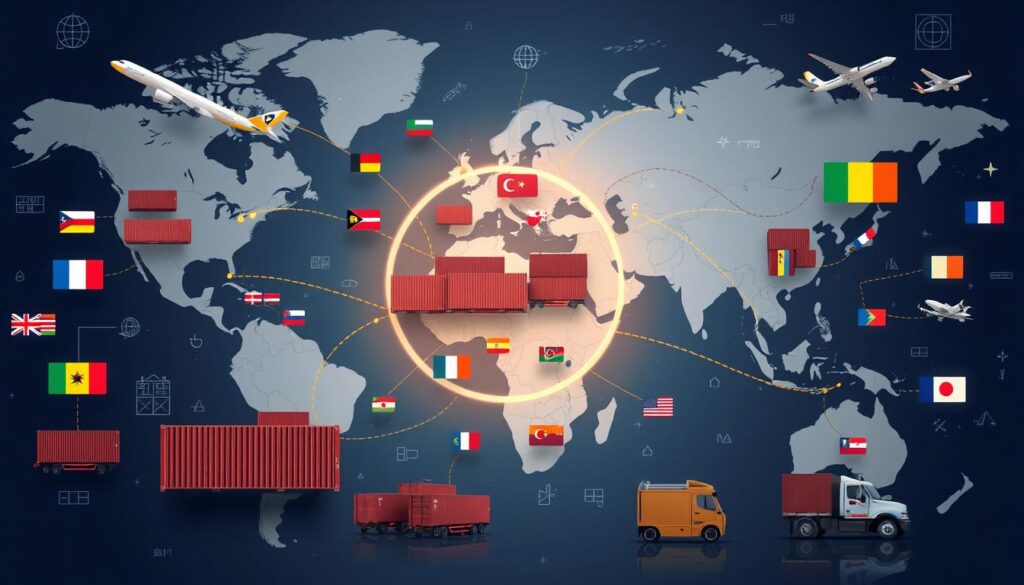
Did you know that about 30% of online store visitors come from outside their country1? As online shopping grows worldwide, your Shopify store must keep up. Not catering to international customers could cost you a lot of money. It’s not just a smart move; it’s a necessity for your Shopify international selling strategy.
Shopify gives brands the tools they need to sell globally. It helps with payments and shipping across borders. For example, you can use Shopify Payments for local payment options, which is key since 49% of shoppers might leave if they can’t pay in their currency1. Also, Shopify lets you sell in up to 20 languages, making shopping better for everyone1.
Shopify lets you grow your business worldwide from one store. Whether you’re small or big, Shopify makes it easy to enter new markets. It supports over 170 countries and helps you meet local payment and product display needs2.
Key Takeaways
- Approximately 30% of an online store’s visitors come from international markets1.
- Shopify supports storeowners in offering local payment methods, preventing cart abandonment1.
- With Shopify, you can sell in up to 20 languages, ensuring global customer engagement1.
- Shopify serves over 170 countries, facilitating seamless international transactions2.
- Expanding your Shopify store internationally is essential for tapping into lucrative markets and maximizing growth potential2.
Understanding International Ecommerce
International ecommerce means selling goods online across borders. It uses global payment and shipping systems for transactions. Brands can see big revenue growth by going global. For instance, some brands have grown their revenue by over 500% with Shopify Managed Markets3.
UK brands like Hello Klean have found it easier to reach markets like the US and the Middle East with Shopify Markets3.
Platforms like Shopify support many currencies, making it easier to serve customers worldwide. Shopify Payments supports currencies like AUD, EUR, and USD, helping to keep customers happy and reduce cart abandonment34. Businesses can quickly adapt to new markets with Shopify’s multi-currency option3.
Geolocation features automatically show prices in local currencies, based on current exchange rates3.
Localization is key in international ecommerce. Shopify’s tools, like Shopify Markets and Expansion Stores, help customize the shopping experience for each region. This includes languages, currency options, and even calculating taxes and tariffs automatically4.
Shopify also integrates with FedEx, UPS, and DHL for real-time shipping rates at checkout. This ensures fast and reliable delivery of international orders4.
Platforms like Shopify are essential for modern businesses. They make it easy to go global and support growth worldwide. Whether expanding into the Middle East or the US, these tools can greatly impact your international sales strategy.
Shopify’s International Sales Tools Overview

Shopify has many tools to help you sell internationally. These include features for localizing your store and shipping solutions. Using these tools can make your international sales strategy better.
Localization Features
Localization is key for international ecommerce. Shopify’s language translation apps help you reach a global audience. The Translate & Adapt app lets you translate into up to two languages for free5.
When content is in a shopper’s native language, they are 65% more likely to buy5. Also, pricing in local currencies can boost conversion rates by up to 40%5. Shopify Payments offers local currencies and payment options, making transactions easier for international customers6.
The Managed Markets feature lets you tailor your store for different regions. This ensures your content connects with consumers from various cultural backgrounds5.
Integrated Shipping Solutions
Managing cross-border shipping can be tough, but Shopify makes it easier. Its shipping solutions have tools for handling global delivery logistics. They include automatic calculation of duties and import taxes at checkout, giving buyers total cost clarity5.
This clarity is crucial for preventing cart abandonment and ensuring a good shopping experience. Shopify also supports smart order routing, which optimizes order fulfillment and reduces delivery times. This makes the shipping process more efficient and customer-friendly5.
In conclusion, using Shopify’s international sales tools is essential for a successful strategy. These tools, from language translation apps to shipping solutions, help you offer a localized and efficient shopping experience. This drives conversions and expands your global reach.
Identifying Target International Markets

Expanding your ecommerce business to new markets is key. Shopify’s location reports help you see where visitors come from. This is crucial for selling worldwide. A deep market analysis for ecommerce is vital for smart decisions.
Analyzing Site Traffic
Understanding your site’s traffic is essential. Shopify offers tools to see sessions, customers, and sales by country. This shows where your business is growing7.
This data helps target your marketing. It also helps you use resources wisely.
Geographic and Cultural Considerations
Entering new markets means knowing their unique traits. This includes language, culture, and economy. Shopify supports 20 languages and over 130 currencies8.
Adapting your store to each market’s culture boosts engagement. This makes your store more relevant to customers.
Also, knowing local consumer habits is important. For example, 80% of international buyers prefer stores in their language9. Making your store accessible in their language improves user experience.
This can cut cart abandonment by 33%9. When expanding internationally, consider these differences. This will help your Shopify store succeed in new markets.
Shopify International Selling Strategy

Expanding your business globally with Shopify needs a solid plan. It’s key to know that 92% of shoppers like to buy in their local currency10. So, using multiple currencies and translating your store into many languages is vital. This can really help your sales, like in Germany, Saudi Arabia, and the UK, where showing local currency can increase sales by a lot11.
To grow internationally, you must think about how to scale. Shopify Markets helps manage settings for different countries, including adding new markets and setting up currencies10. With these tools, you can easily grow in various areas, depending on your plan. Basic Shopify lets you handle up to three markets, while Shopify Plus can handle up to 5010.
- 92% of shoppers prefer local currency10
- Conversion rates increase significantly with local prices11
- Basic Shopify allows up to three markets, Shopify Plus up to 5010
Another important part of your strategy is using Shopify’s shipping solutions. Shopify has deals on international shipping, saving up to 88% with USPS, UPS, and DHL Express11. This helps keep costs down while you grow your business.
… “92% of shoppers prefer to shop on websites that display their local currency.”10
Also, Shopify Markets Pro makes handling international rules, taxes, duties, and shipping easier. It works in over 150 markets, helping US merchants grow globally11. These tools make sure your marketing is not just good but also follows global rules. This lets you focus on reaching new customers and giving them a great experience.
Managing Multicurrency Payments

Handling payments in different currencies is key for selling internationally on Shopify. Shopify Payments lets customers pay in their own currency. This makes shopping smoother for them.
Shopify Payments and Currency Conversion
Shopify supports multiple currencies, allowing for automatic or custom conversion rates. This flexibility helps sellers set prices effectively. It’s important because 92% of shoppers prefer to buy in their local currency12.
Also, 76% of online shoppers like to buy in their local currency. And 70% might leave their cart if prices aren’t in their currency13. Companies like Doyoueven saw big growth after adding multi-currency support12.
Tax and Duty Management
Managing taxes and duties is crucial for international online sales. It keeps businesses in line with laws and builds trust with customers. You can show prices with or without taxes and handle import fees.
Taxes in online shopping are getting more complex. But, new tools are coming to make it easier13. For example, 55% of shoppers leave their carts because of extra fees in different currencies13. It’s vital to have clear pricing.
Businesses also need to update prices often. This is because of changes in currency value due to inflation or market shifts. Keeping prices competitive and accurate is essential12.
Setting Up International Shipping

Setting up international shipping on Shopify is complex. It requires a detailed approach. By understanding and applying the best strategies, you can reach more customers worldwide. This way, you can keep shipping costs low.
Choosing Reliable Carriers
Choosing the right shipping carriers is key for success in international ecommerce. Carriers like USPS, UPS, DHL, and Canada Post offer big discounts. These discounts can cut down your shipping costs a lot.
USPS gives discounts from 64.5% to 88.5% for domestic and 5.0% to 10.4% for international shipping14. UPS offers up to 73.43% off for international shipments14. DHL’s discounts range from 71.5% to 76.0% for international shipping14. Canada Post offers discounts from 45.0% to 52.6% for international shipments14. Using these carriers in Shopify can make your shipping more efficient and cheaper.
Shipping Costs and Times
Managing shipping costs and times is vital for a good customer experience. Being clear about shipping costs and times helps build trust with your customers. The cost of packaging and shipping can change a lot based on the products.
Choosing products that are easy to ship can help keep costs low. This can also increase your international sales15. Duties and taxes, which are a percentage of the sale price, also affect shipping costs15. Make sure to tell customers about these costs at checkout.
To improve your Shopify international shipping strategies, consider these steps:
- Use the Shopify Markets feature for better duties management, custom pricing, and managing language and currency from one place16.
- Install apps like ShipStation for easier global shipping and fulfillment16.
- Use tools like Global-e or Avalara Avatax to automate taxes and duties based on the customer’s location16.
Localizing Your Shopify Store

To succeed in the global ecommerce market, focusing on Shopify store localization is key. It meets the needs of a wide audience, making shopping better, increasing sales, and making customers happier.
Multi-language Support
Having support for many languages in your Shopify store is vital. This is because 76% of online shoppers prefer to buy in their native language17. Also, 75% of consumers like to buy in their native language, showing the importance of being multilingual18. Shopify lets merchants offer a better shopping experience by setting up multiple languages. It automatically changes content based on where the user is from.
This effort can bring more visitors and sales, as 40% of online shoppers won’t buy from sites in other languages17.
International Domain Strategy
Having a good international domain strategy is also crucial for Shopify store localization. Using local domains or subdomains for different markets can boost SEO rankings. This is because companies that localize may see better search engine visibility in their target countries17.
This strategy not only increases organic traffic but also builds trust with consumers. Localized domains connect better with local audiences. Shopify makes this easier by automating hreflang tags. This ensures search engines show the right version of your site to users based on their location.
The table below shows the benefits of Shopify’s multi-language and international domain strategies:
| Feature | Benefit |
|---|---|
| Multi-language Support | 75% of consumers prefer native languages18, leading to increased satisfaction and sales. |
| Localized Domains | Improved SEO and customer trust in target markets. |
| Hreflang Tags | Automated by Shopify, ensuring the correct page version displays based on user’s location. |
| Expanded Market Reach | Potential for reaching a global audience and gaining a competitive edge17. |
By using these effective ecommerce localization strategies, merchants can easily enter new markets. This drives growth and helps establish a strong presence worldwide. The global cross-border B2C ecommerce market is expected to grow to about 8 trillion US dollars by 2030. This shows a big chance for localized Shopify stores to succeed18.
Tailoring Marketing Content for Global Audiences

To grow your Shopify business globally, you need a smart marketing plan. This plan must consider the different cultures of your target markets. It’s not just about translating words; it’s about understanding what people like and how they behave.
Localized Ads and Campaigns
Creating ads that speak to local tastes is key to winning new customers. You must do your homework to know what people want and how they act. This way, your messages will hit the mark with each region19.
Shopify has teamed up with Global-e to make things easier. They handle things like prices, stock, and taxes for you. This makes shopping less scary and boosts sales20.
To really connect, you need to tailor your products and ads to fit each culture. It’s not just about speaking their language. It’s about working with local businesses to get in the game fast and look good doing it19. Good cultural marketing can make your Shopify strategy shine.
Social Media Localization
Social media is a big deal for reaching out to people in different places. Having separate accounts for each area lets you focus better. It’s all about getting the local vibe right and making your content pop.
Shopify has tools to help you automate, segment, and track your marketing. Personalizing your social media can make a huge difference. And since 44% of people start their shopping online, making sure your site is easy to find is crucial20.
Being quick to change based on what people say is vital. You have to follow rules about shipping, taxes, and keeping data safe when selling across borders20. By listening to your customers and using what you learn, your marketing will get better and better. This will help your Shopify business grow and thrive.
Understanding Customer Preferences in Different Markets
To succeed in international e-commerce, you must deeply understand customer behavior. People in various regions have unique preferences that affect your business. For example, Americans value fast shipping and great customer service. On the other hand, Japanese customers expect precise and reliable delivery21.
By knowing these differences, you can fine-tune your Shopify strategy for international sales. This makes your business more appealing to customers worldwide.
Tools like Google Analytics and Google Search Console provide insights into your website’s traffic. They show which countries are most interested in your store. This information helps you offer content that locals can relate to.
In Europe, for instance, people expect websites in their own languages, like German or Spanish21. Meeting these expectations can improve their shopping experience. Also, using local payment methods, like WeChat in China, can increase sales21.
Shopify Markets lets you set prices for each region. You can choose between fixed or real-time exchange rates, making it easier to manage22. Training your customer service team on cultural sensitivity and language is key. This ensures customers feel valued, no matter where they are.
Adapting your products and services to local tastes is crucial for success. It’s not just a strategy; it’s a must in the competitive international market.
🌍 Unlock Global Revenue: Start Your International Shopify Empire NOW!
Conversion Trigger: Empowerment & Opportunity
FAQ
What is international ecommerce?
International ecommerce is selling online across borders. It uses global payment systems and shipping networks. It also deals with different rules and logistics.
Why is it necessary to serve a global audience?
About 30% of online store visitors are from abroad. Serving a global audience opens up new customers. This can grow your sales and reach.
What tools does Shopify provide for international selling?
Shopify gives brands tools for international sales. It helps manage payments, set up shipping, and make websites for different places.
How can I localize my Shopify store?
Shopify has features for localizing your store. You can use language apps and set up international domains. This makes your store friendly for different places.
How do I identify target international markets?
Shopify’s location reports help find where visitors come from. This data shows where to focus your efforts for international sales.
What factors should I consider when expanding internationally?
Think about the place and culture you’re entering. Look at language, behavior, and what people like. This helps you sell better in different places.
What is Shopify Payments, and how does it help with multicurrency payments?
Shopify Payments makes it easy to pay in local currencies. It handles conversions smoothly, making transactions easy for customers worldwide.
How do I manage international taxes and duties on Shopify?
Shopify helps show prices with or without taxes. It also makes paying import fees easier. This keeps your customers informed and happy.
What are some strategies for managing cross-border shipping costs?
Pick good carriers and set up shipping zones in Shopify. Be clear about shipping costs and times. Offer different shipping options to meet customer needs.
How can I create localized marketing campaigns?
Customize your marketing for each market. Use local ads and campaigns. Setting up social media for different areas helps reach more people.
What’s the importance of understanding consumer preferences in different markets?
Knowing what people like in different places is key. Use data to make your products fit local tastes. This keeps customers happy and loyal.
Source Links
- https://www.shopify.com/blog/international-ecommerce – International Ecommerce: How To Sell Globally Online (2024) – Shopify
- https://www.shopify.com/international – Sell to International Customers with Shopify
- https://www.shopify.com/enterprise/blog/international-ecommerce-strategy – 10 Steps to Build a Winning International Ecommerce Strategy for 2024 – Shopify
- https://crawlapps.com/blogs/news/a-guide-to-international-ecommerce-in-shopify – A Guide To International Ecommerce In Shopify – Shopify Website Development Agency in USA | CrawlApps
- https://www.shopify.com/blog/international-sales-tools – Grow Your Business Globally With International Sales Tools (2023) – Shopify
- https://www.shopify.com/international/features – Explore Features of Shopify’s international sales tools
- https://www.shopify.com/ca/blog/international-marketing – International Marketing: Strategies To Gain a Competitive Edge (2024) – Shopify Canada
- https://herd.io/blogs/shopify/shopify-international-selling-tips?srsltid=AfmBOooZuDCfPTBqMvkwO1YqYxfJ1DPgxMAR2OqoPyKzz8VtvicZjSn7 – Our top 6 tips for selling internationally on Shopify
- https://www.charleagency.com/articles/selling-internationally-on-shopify/ – How to sell internationally on Shopify
- https://digitalsuits.co/blog/international-selling-on-shopify-how-to-set-up-your-store-for-global-sales/ – International Selling on Shopify: How to Set Up Your Store for Global Sales | DigitalSuits
- https://blog.adnabu.com/shopify/shopify-international/ – How To Sell Internationally On Shopify?
- https://www.shopify.com/enterprise/blog/multi-currency – Multi-currency Ecommerce: Benefits and How to Use (2024) – Shopify
- https://getshogun.com/learn/shopify-multi-currency – The Easy Way to Implement Multiple Currencies on Shopify
- https://blog.shipperhq.com/2024/04/shopify-international-shipping – Shopify International Shipping: A Beginner’s Guide
- https://burstcommerce.com/guides/shopify-international-shipping/ – How To Set Up International Shipping on Shopify
- https://tribe.digital/insights/how-to-sell-internationally-on-shopify – How to sell internationally on Shopify? 🌎 | Tribe Digital
- https://www.linguise.com/blog/guide/shopify-store-localization-the-ultimate-guide/ – Shopify Store Localization: The Ultimate Guide
- https://getshogun.com/learn/shopify-localization-guide – Everything brands need to know about Shopify Localization
- https://praella.com/blogs/shopify-insights/navigating-shopify-cultural-marketing-a-strategic-guide – Navigating Shopify Cultural Marketing: A Strategic Guide | Praella
- https://www.meetdomaine.com/insights/technology/internationalization-guide-for-shopify/ – Blog Article | Internationalization Guide for Shopify Brands | Domaine
- https://bloggle.app/blog/how-to-sell-internationally-on-shopify – How to Sell Internationally on Shopify? (Must Knows in 2024)
- https://onescales.com/blogs/main/shopify-markets – Shopify Markets International Sales Tutorial



